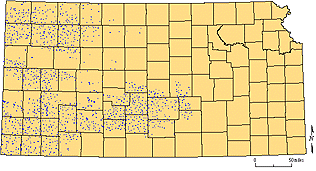What is the Water Well Project?
Ground water is the primary water source for much of western Kansas. In order to effectively manage ground-water use, changes in water levels and the associated saturated thickness in aquifers are regularly and accurately monitored. As part of a statewide program, over 1,400 wells in 47 central and western Kansas counties are measured annually.
How are wells measured?
Techniques for measuring water levels are well established. A lead weight is attached to the end of a steel measuring tape. The weight pulls the end of the tape downward. Blue chalk is rubbed on the end of the measuring tape to help easily distinguish wet from dry. The depth from the surface to the top is calculated by subtracting the length of the wet part of the tape from the amount of tape lowered into the well hole.
Who measures the wells?
The program is sponsored by the Division of Water Resources and the Kansas Geological Survey. Water levels generally are measured in January by staff from the DWR and the KGS.
How are wells selected for the program?
A representative sampling of wells is made, so that the resulting measurements provide an accurate but cost-effective snapshot of water levels in the aquifer. Wells included in the annual water-level census are selected based on the following characteristics:
- what aquifer they penetrate
- the presence of substantial amounts of water in the aquifer
- where the wells are located
- how they were constructed
- the amount of historical data available
- how the wells are used
In general, one well in every 16-square-mile area is measured.
How are wells marked?
Once a well has been sucessfully measured, a weather-resistant tag is attached to the well so landowners can tell, from a distance, that their well has been measured. Different colored tags are used each year. The tags provide information about well location, landowner's name, measuring agency, measurement access, obstructions, the quality of the water line, oil on water, remarks, depth to water in the current year, depth to water in the two previous years, date, and measurer identification. Tags are for the convenience and information of owners or operators, who can remove the tags if they so choose.
How can you be sure the correct well is being measured?
For the water-level data to be useful, it is critical that the same well be sampled each year using identical methods. Map-reading errors, incorrect legal descriptions, and confusion with nearby wells can lead to misidentification. To eliminate such errors, KGS researchers have begun usuing a computer system called Water Witch, which uses Global Positioning System (GPS) technology and an extensive digital map system to accurately locate wells in relation to such geographic landmarks as towns, highways, roads, houses, and rivers and streams. Besides acting as a navigational aid and data recorder, Water Witch combines detailed site comments and photographs to enhance and improve location certainty, well familiarity, and visual identification.
What about quality control?
Quality-control procedures are an important part of the water-level measurement program. Wells with measurements that deviated from the local trends during the initial visit are revisited and remeasured to confirm the recorded water depths. Wells that were not successfully measured during the primary trip also are revisited. In addition, about 6% of the wells measured by the KGS are randomly selected for remeasurement to make sure they were accurately measured during the initial trip that year.
What happens to the data collected?
Once data from the annual water-level measurement program are recorded and checked, they are entered into WIZARD and electronically available to the public. Various kinds of scientific analysis that follow the yearly data acquisition--including determinations of saturated thickness, depth to water, depletion trends, and water-resource predictions--are all possible using software that can directly access WIZARD.
What is WIZARD?
Both the current year's measurements and historical water-level data are archived and maintained at the KGS in a large, statewide computer database known as Water Information Storage and Retrieval Database (WIZARD). This centralized database can be accessed through the World Wide Web at http://www.kgs.ku.edu/Magellan/WaterLevels/index.html or on CD-ROM. Information on Kansas ground-water resources can be obtained for areas as small as a section or as large as the entire state. Data analysis, reports, and general queries also are available on the more than 50,000 wells that make up its primary inventory.
How is the data used?
Data gathered from well measurements are used for a variety of purposes, both public and private. Organizations and governmental agencies use the data, especially in mapped form, to develop an understanding of trends in regional water levels. That understanding is then used in making decisions about water and in taking regulatory actions. Groundwater management districts use the results to better understand water levels in their area. The Division of Water Resources of the Kansas Department of Agriculture uses the data in making decisions about applications for new water rights and in declaring and regulating intensive groundwater use control areas, where new ground-water pumping is extremely limited. Private institutions use the measurements to appraise the value of land and in making lending decisions. Private landowners use the data to monitor water levels in their own wells and in those nearby. All of these uses depend on high quality data about water levels.
